The ASRock Z170 Extreme7+ Review: When You Need Triple M.2 x4 in RAID
by Ian Cutress on November 27, 2015 11:59 AM EST- Posted in
- Motherboards
- ASRock
- M.2
- Skylake
- Z170
CPU Performance, Short Form
For our motherboard reviews, we use our short form testing method. These tests usually focus on if a motherboard is using MultiCore Turbo (the feature used to have maximum turbo on at all times, giving a frequency advantage), or if there are slight gains to be had from tweaking the firmware. We leave the BIOS settings at default and memory at JEDEC (DDR4-2133 C15) for these tests, making it very easy to see which motherboards have MCT enabled by default.
Video Conversion – Handbrake v0.9.9: link
Handbrake is a media conversion tool that was initially designed to help DVD ISOs and Video CDs into more common video formats. For HandBrake, we take two videos (a 2h20 640x266 DVD rip and a 10min double UHD 3840x4320 animation short) and convert them to x264 format in an MP4 container. Results are given in terms of the frames per second processed, and HandBrake uses as many threads as possible.

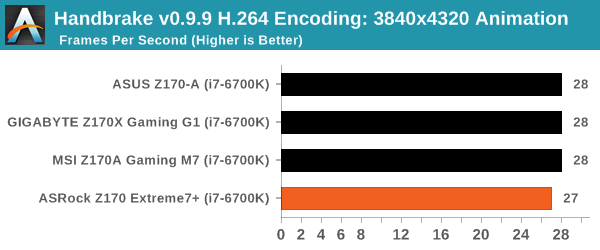
Compression – WinRAR 5.0.1: link
Our WinRAR test from 2013 is updated to the latest version of WinRAR at the start of 2014. We compress a set of 2867 files across 320 folders totaling 1.52 GB in size – 95% of these files are small typical website files, and the rest (90% of the size) are small 30 second 720p videos.
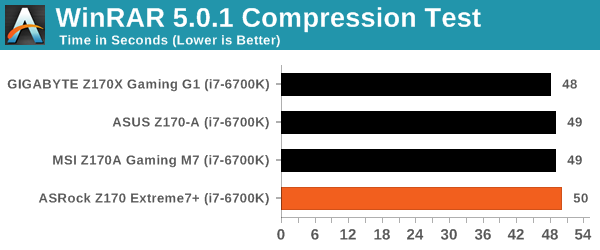
Point Calculations – 3D Movement Algorithm Test: link
3DPM is a self-penned benchmark, taking basic 3D movement algorithms used in Brownian Motion simulations and testing them for speed. High floating point performance, MHz and IPC wins in the single thread version, whereas the multithread version has to handle the threads and loves more cores. For a brief explanation of the platform agnostic coding behind this benchmark, see my forum post here.
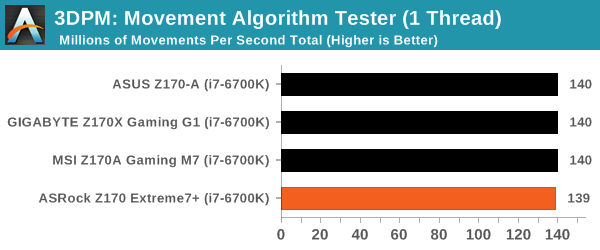
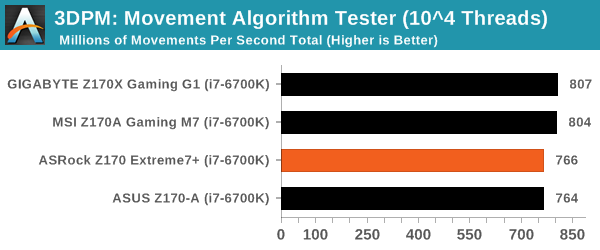
Image Manipulation – FastStone Image Viewer 4.9: link
Similarly to WinRAR, the FastStone test us updated for 2014 to the latest version. FastStone is the program I use to perform quick or bulk actions on images, such as resizing, adjusting for color and cropping. In our test we take a series of 170 images in various sizes and formats and convert them all into 640x480 .gif files, maintaining the aspect ratio. FastStone does not use multithreading for this test, and thus single threaded performance is often the winner.
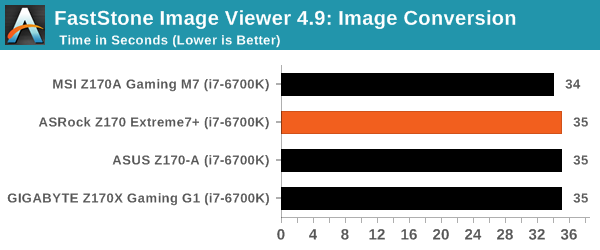
Rendering – PovRay 3.7: link
The Persistence of Vision RayTracer, or PovRay, is a freeware package for as the name suggests, ray tracing. It is a pure renderer, rather than modeling software, but the latest beta version contains a handy benchmark for stressing all processing threads on a platform. We have been using this test in motherboard reviews to test memory stability at various CPU speeds to good effect – if it passes the test, the IMC in the CPU is stable for a given CPU speed. As a CPU test, it runs for approximately 2-3 minutes on high end platforms.
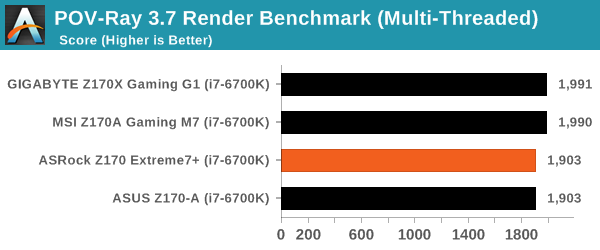
Synthetic – 7-Zip 9.2: link
As an open source compression tool, 7-Zip is a popular tool for making sets of files easier to handle and transfer. The software offers up its own benchmark, to which we report the result.











63 Comments
View All Comments
Kutark - Sunday, November 29, 2015 - link
Did i miss the HUGE opportunity to nerd out and test triple m.2 sata express RAID array transfer speeds? I see no benchmarks...scottjames_12 - Sunday, November 29, 2015 - link
Correct me if I am wrong, but with all 3 M.2 ports hanging off the Z170 PCH (which they must be if they are RAID capable), isn't the bottleneck going to be the DMI link from the PCH to the CPU? Which is essentially a PCIe 3.0 x4 connection, with maximum theoretical bandwidth of 3938.4 MBps. Seems to be confirmed by the numbers ASRock quoted, as 3 SSD750's should be able to hit over 8000 MBps sequential, but they only managed 3500.extide - Monday, November 30, 2015 - link
YEPMax Hereticus - Sunday, November 29, 2015 - link
Bought the ASRock Extreme 6 for my I7 6700k. What a piece of shit.. still in the middle of the RMA process. ASRock tech support and quality leave a lot to be desired. Nice Motherboards except they last less than 2 months.extide - Monday, November 30, 2015 - link
Your anecdotal references/experiences are basically worth nothing in the grand scheme of things, ya know.fackamato - Sunday, November 29, 2015 - link
No benchmarks from the x3 M2 in RAID?firstmithrandir - Monday, November 30, 2015 - link
Is there any possibility to test it with more than one SSD disks like it is claimed in the tittle: "The ASRock Z170 Extreme7+ Review: When You Need Triple M.2 x4 in RAID article"?At the moment the tittle of article is misleading.
asgallant - Monday, November 30, 2015 - link
Even if z170 breaks out enough connections for 3 M.2 PCIe x4 slots, aren't you still limited to the aggregate bandwidth across the DMI? The 4 DMI lanes between the chipset and CPU are roughly (exactly?) the same bandwidth as 4 PCIe 3.0 lanes. Maybe RAID could provide some improvement on drives that cannot completely use the ~3.85GB/s of bandwidth that 4 PCIe 3.0 lanes provides, but you're not likely to see much, I think.fackamato - Monday, November 30, 2015 - link
Still, that's >1GB/s per SSD.Plus, triple RAID0 would increase random IOPS as well right.
Ethos Evoss - Wednesday, December 2, 2015 - link
Sooo useless and pointless and ''BLACK HOLE'' expensive !!